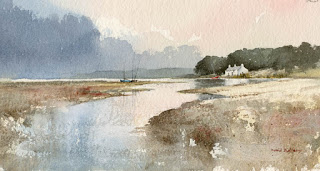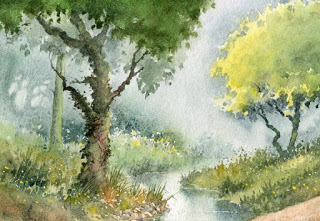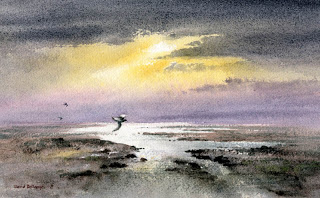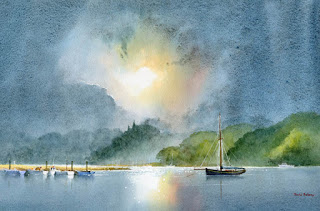One aspect of life I am really missing in lockdown is being by the sea, and especially my native Pembrokeshire with it’s incomparable combination of sandy beaches and stunning cliff scenery. I’m desperately in need of being splashed in the face by some wild breaker crashing on the rocks, so I thought you might like to see how I tackle these fascinating actions of the sea.
This is the sort of sea that all self-respecting sailors should be indoors, but the kind I love to catch in a sketch. Just being there and observing what happens when the sea crashes onto the rocky anvils helps you understand what is going on, and happily it is repeating itself all the time. I often stand mesmerised by these moving images, then snap out of my reverie and consider how I would render the effect in watercolour. By watching every part of that moving scene in succession you will learn a lot about moving water and a sketchbook plus a watersoluble pencil will help you record the moment without any need to be completely accurate.
To capture the white splashes in this painting I brought down the cliff colour – light red with spots of cadmium red here and there at the top, then halfway down introducing purple – a mixture of cadmium red and French ultramarine – for the lower cliff. I laid it down as a very wet wash, but as I came closer to the rocky anvils I wiped the brush on a towel to lose the excess liquid and then rolled the number ten round sable on its belly around the top of the rocks. This created an intermittent and ragged edge of purple around the white of the paper above the rocks. Where it went wrong and left an ugly mark as sometime happens I quickly pulled out the offending splodge with a damp brush, although if I can’t manage that at the time I simply let it dry and then scrub it out with a damp old brush (not your brand new number ten sable!). This was painted on the beautiful Saunders Waterford rough surface which helps enormously to create the ragged edges round the splashes as well as rock textures. A NOT surface will work well but the rough version will help you even more in this instance. There are many examples of these various techniques for rendering waves and sea action in my book Seas & Shorelines in Watercolour which can be obtained from my website http://www.davidbellamy.co.uk
There are other ways of capturing these splashes – sometimes I wet the area above the rocks and then lower the purple wash (or whatever colour I am using) into the wet area, working it round the splash. This has a lovely clean effect but you often will need to adjust the shape of the splash by pulling out colour with a damp brush. Try these lovely effects out on scrap watercolour paper first and have fun! Right, without the sea and on a very hot day here I think it’s time to go and jump in the river………….. take care!





